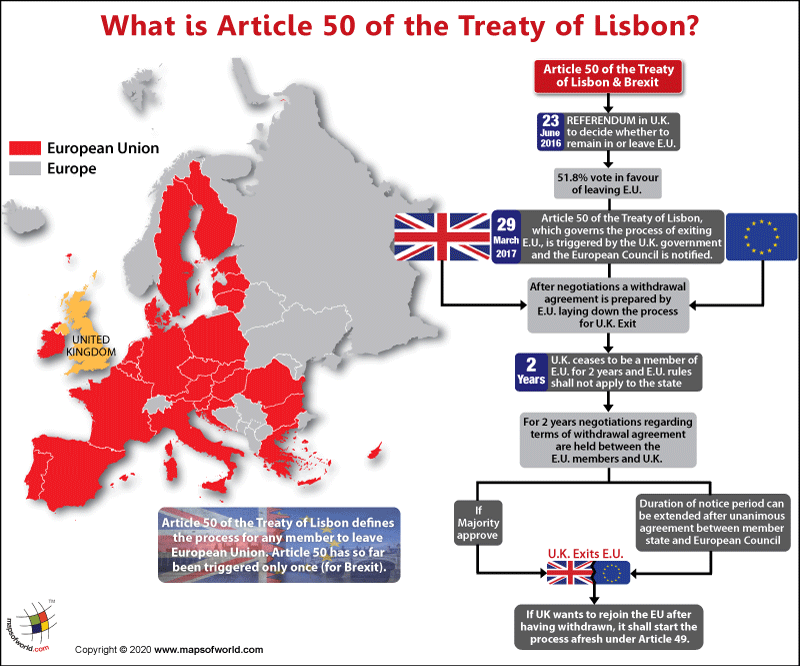What is Article 50 of the Treaty of Lisbon?

On March 29th, 2017, Theresa May, the former Prime Minister of the United Kingdom, wrote a letter to Donald Tusk, the President of the European Council, notifying him of the UK’s exit from the EU (popularly referred to as Brexit). The letter served to trigger Article 50 of the Lisbon Agreement – a formal exit clause that sets in motion the exit process of the UK from the EU. Before we understand Article 50, let us take a look at the Lisbon Agreement itself.
The European Union or EU is a partnership of 27 nations (28 nations, before the exit of the UK) from Europe. The EU functions as a single market with freedom of trade, movement, and residence accorded to the citizens of member states. Most of the EU member states also use the Euro as a common currency.
The Maastricht Treaty, which was signed in the year 1992, laid the foundation for the formation of the European Union. It brought together members of the European Economic Community (EEC) who were all signatories of the Treaty of Rome (effective, 1958) to form the EU. The foundations of the EU were solidified by the signing of the Treaty on European Union in 2007 along with others which laid down the guidelines for the functioning of the EU. The Treaty of Lisbon (signed in 2007) introduced amendments to the Treaty on the European Union and the Treaty of Rome. It is considered to be the constitutional basis for the functioning of the EU. Article 50 of the Treaty defines the process for any member to leave the European Union. Article 50 of the Lisbon Treaty has so far been triggered only once (in the context of the Brexit).
Implications of Article 50
Article 50 states that
- Any member state of the EU is free to withdraw from the Union “in accordance with its own constitutional requirements,” i.e. if deemed right by its lawfully elected government and the people.
- The member state shall notify the European Council of its intention to withdraw when such a decision is made. The EU shall then draw up an agreement with that state, laying down the specific process for its withdrawal and set up a framework for future interactions between the state and the EU.
- The withdrawing member state shall cease to be a member two years from the date of notification, and then the EU Treaties, guidelines, etc. shall not apply to the state.
- The withdrawing member state shall not participate in the discussions of the European Council.
- If the state asks to rejoin the EU after having withdrawn, it shall be subject to the provisions mentioned in Article 49 (of the Lisbon Treaty).
The UK decided to trigger Article 50 of the Lisbon Treaty after a historic referendum held on June 23rd, 2016. In this referendum, the majority (51.8 percent of the votes cast) voted in favor of leaving the EU. In the following years, the withdrawal process took place and even got delayed. Finally, on January 30, 2020, at 11 p.m. (GMT), the UK left the EU.
Related Links:
Related Map:

